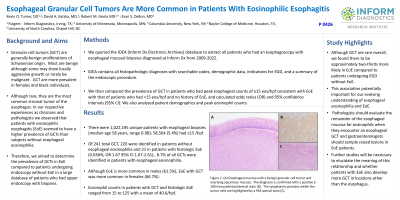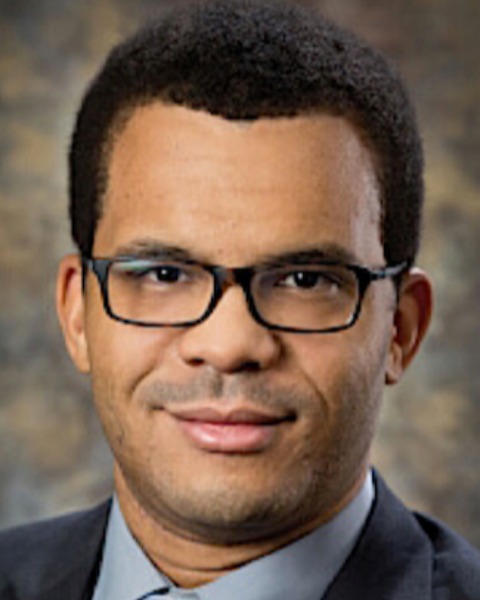Sunday Poster Session
Category: Esophagus
P0426 - Esophageal Granular Cell Tumors Are More Common in Patients With Eosinophilic Esophagitis
Sunday, October 22, 2023
3:30 PM - 7:00 PM PT
Location: Exhibit Hall

Has Audio

Kevin Turner, DO
University of Minnesota
Minneapolis, Minnesota
Presenting Author(s)
Kevin Turner, DO1, David A.. Katzka, MD2, Evan S. Dellon, MD, MPH3, Robert M. Genta, MD4
1University of Minnesota, Minneapolis, MN; 2New York Presbyterian-Columbia, New York, NY; 3University of North Carolina School of Medicine, Chapel Hill, NC; 4Baylor College of Medicine, Irving, TX
Introduction: Granular cell tumors (GCT) are generally benign proliferations of Schwannian origin. Although rare, they are the most common stromal tumors of the esophagus. In our respective experiences as clinicians and pathologists we observed that patients with eosinophilic esophagitis (EoE) seemed to have a higher prevalence of GCTs than subjects without esophageal eosinophilia. Therefore, we aimed to determine the prevalence of GCTs in EoE compared to patients undergoing endoscopy without EoE in a large database of patients who had upper endoscopy with biopsies.
Methods: We queried the IDEA (Inform Dx Electronic Archives) to extract all patients who had an esophagoscopy with esophageal mucosal biopsies diagnosed at Inform Dx from 2009-2022. IDEA contains all histopathologic diagnoses with searchable codes, demographic data, indications for EGD, and a summary of the endoscopic procedure. We then compared the prevalence of GCT in patients who had peak esophageal counts of ≥15 eos/hpf consistent with EoE with that of patients who had < 15 eos/hpf and no history of EoE, and calculated odds ratios (OR) and 95% confidence intervals (95% CI). We also analyzed patient demographics and peak eosinophil counts.
Results: There were 1,022,195 unique patients with esophageal biopsies (median age 58 years, range 0-98); 58,564 (5.4%) had ≥15 /hpf. Of 241 total GCT, 220 (0.021%) were identified in patients without esophageal eosinophilia and 21 (0.036%) in patients with histologic EoE (0.036%; OR 1.67 95% CI 1.07-2.61); 8.7% of all GCTs were identified in patients with esophageal eosinophilia. Although EoE is more common in males (61.5%), EoE with GCT was more common in females (66.7%). Eosinophil counts in patients with GCT and histologic EoE ranged from 15 to 125 with a mean of 40.6/hpf.
Discussion: Although GCT are rare overall, we found them to be approximately two-thirds more likely in EoE compared to patients undergoing EGD without EoE. This association potentially important for our evolving understanding of esophageal eosinophilia and EoE. Pathologists should evaluate the remainder of the esophageal mucosa for eosinophils when they encounter an esophageal GCT. Further studies will be necessary to elucidate the meaning of this relationship and whether patients with EoE also develop more GCT in locations other than the esophagus.
Disclosures:
Kevin Turner, DO1, David A.. Katzka, MD2, Evan S. Dellon, MD, MPH3, Robert M. Genta, MD4. P0426 - Esophageal Granular Cell Tumors Are More Common in Patients With Eosinophilic Esophagitis, ACG 2023 Annual Scientific Meeting Abstracts. Vancouver, BC, Canada: American College of Gastroenterology.
1University of Minnesota, Minneapolis, MN; 2New York Presbyterian-Columbia, New York, NY; 3University of North Carolina School of Medicine, Chapel Hill, NC; 4Baylor College of Medicine, Irving, TX
Introduction: Granular cell tumors (GCT) are generally benign proliferations of Schwannian origin. Although rare, they are the most common stromal tumors of the esophagus. In our respective experiences as clinicians and pathologists we observed that patients with eosinophilic esophagitis (EoE) seemed to have a higher prevalence of GCTs than subjects without esophageal eosinophilia. Therefore, we aimed to determine the prevalence of GCTs in EoE compared to patients undergoing endoscopy without EoE in a large database of patients who had upper endoscopy with biopsies.
Methods: We queried the IDEA (Inform Dx Electronic Archives) to extract all patients who had an esophagoscopy with esophageal mucosal biopsies diagnosed at Inform Dx from 2009-2022. IDEA contains all histopathologic diagnoses with searchable codes, demographic data, indications for EGD, and a summary of the endoscopic procedure. We then compared the prevalence of GCT in patients who had peak esophageal counts of ≥15 eos/hpf consistent with EoE with that of patients who had < 15 eos/hpf and no history of EoE, and calculated odds ratios (OR) and 95% confidence intervals (95% CI). We also analyzed patient demographics and peak eosinophil counts.
Results: There were 1,022,195 unique patients with esophageal biopsies (median age 58 years, range 0-98); 58,564 (5.4%) had ≥15 /hpf. Of 241 total GCT, 220 (0.021%) were identified in patients without esophageal eosinophilia and 21 (0.036%) in patients with histologic EoE (0.036%; OR 1.67 95% CI 1.07-2.61); 8.7% of all GCTs were identified in patients with esophageal eosinophilia. Although EoE is more common in males (61.5%), EoE with GCT was more common in females (66.7%). Eosinophil counts in patients with GCT and histologic EoE ranged from 15 to 125 with a mean of 40.6/hpf.
Discussion: Although GCT are rare overall, we found them to be approximately two-thirds more likely in EoE compared to patients undergoing EGD without EoE. This association potentially important for our evolving understanding of esophageal eosinophilia and EoE. Pathologists should evaluate the remainder of the esophageal mucosa for eosinophils when they encounter an esophageal GCT. Further studies will be necessary to elucidate the meaning of this relationship and whether patients with EoE also develop more GCT in locations other than the esophagus.
Disclosures:
Kevin Turner indicated no relevant financial relationships.
David Katzka: Medtronic – Grant/Research Support.
Evan Dellon indicated no relevant financial relationships.
Robert Genta indicated no relevant financial relationships.
Kevin Turner, DO1, David A.. Katzka, MD2, Evan S. Dellon, MD, MPH3, Robert M. Genta, MD4. P0426 - Esophageal Granular Cell Tumors Are More Common in Patients With Eosinophilic Esophagitis, ACG 2023 Annual Scientific Meeting Abstracts. Vancouver, BC, Canada: American College of Gastroenterology.
